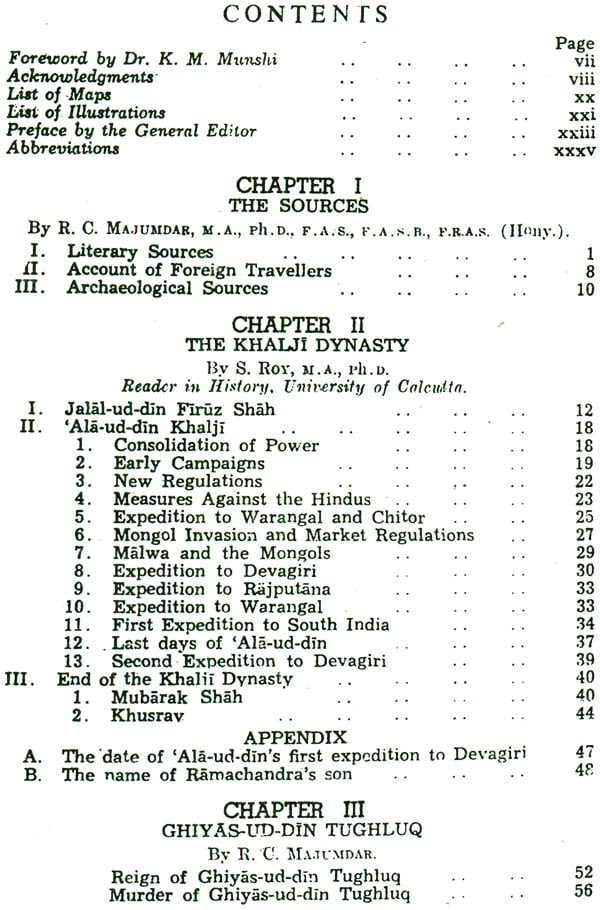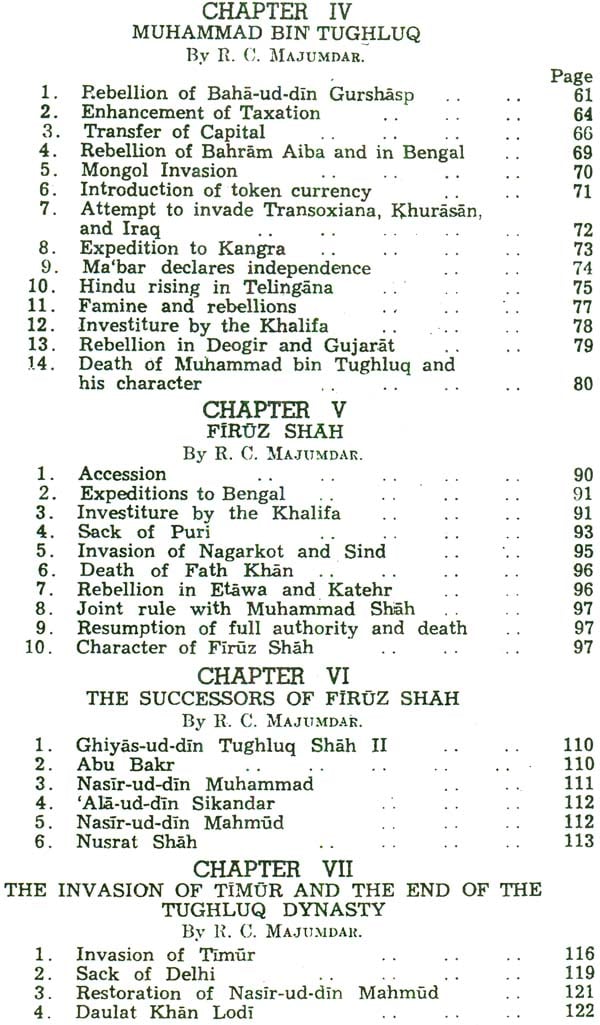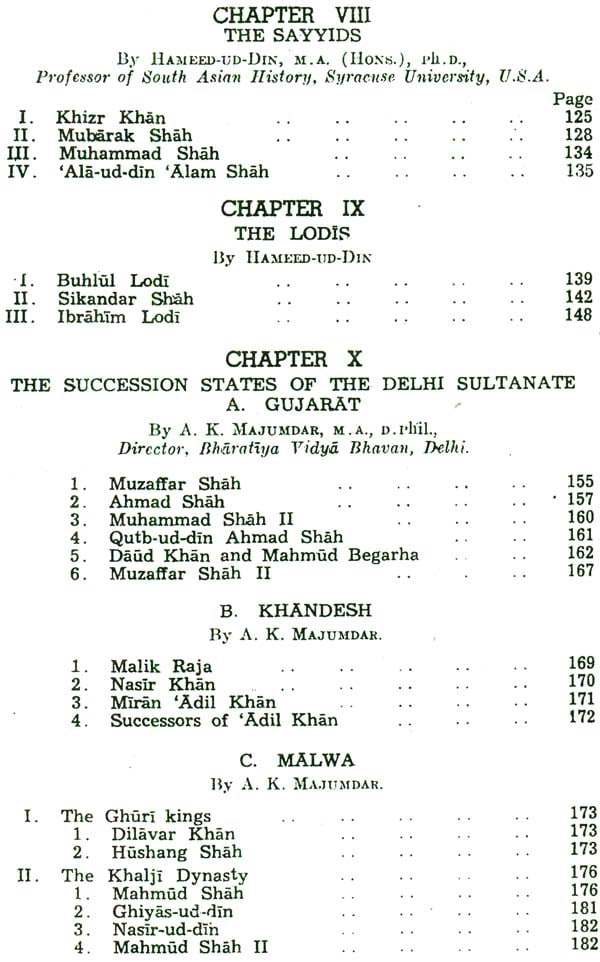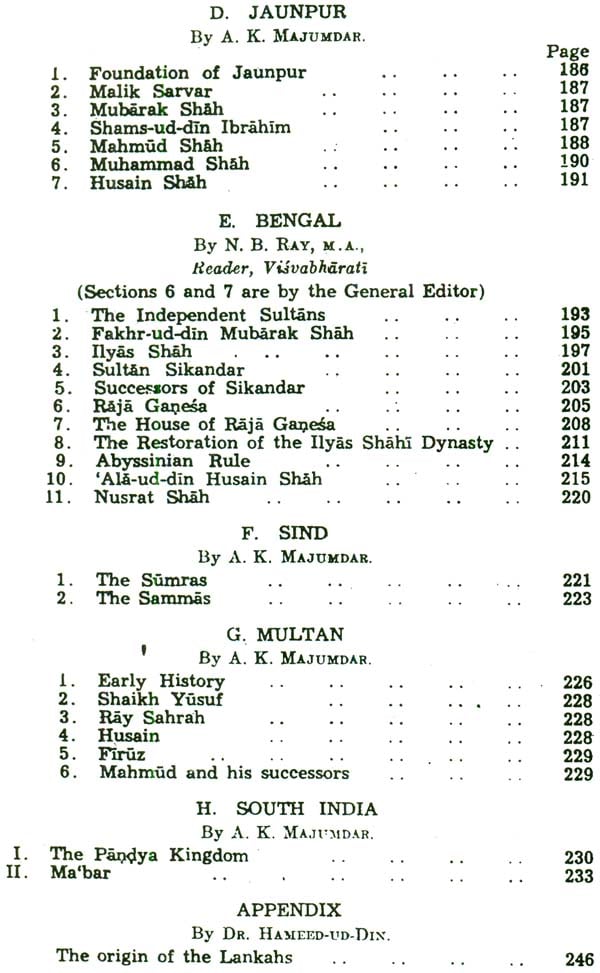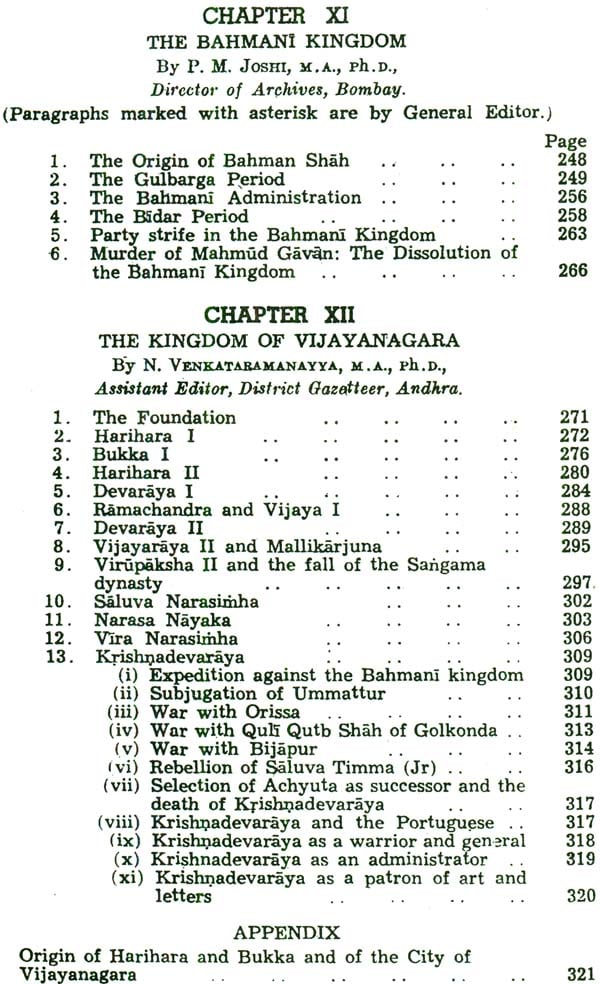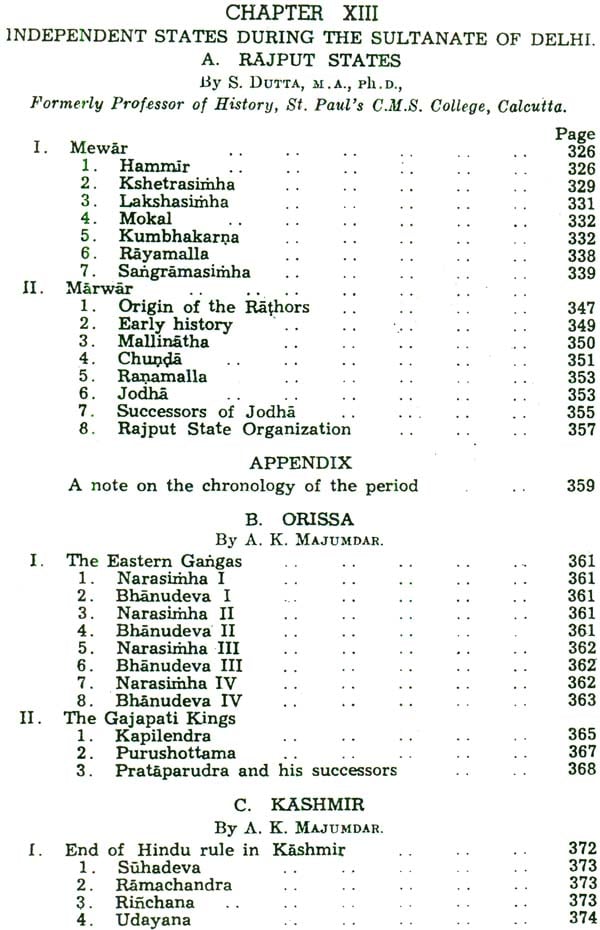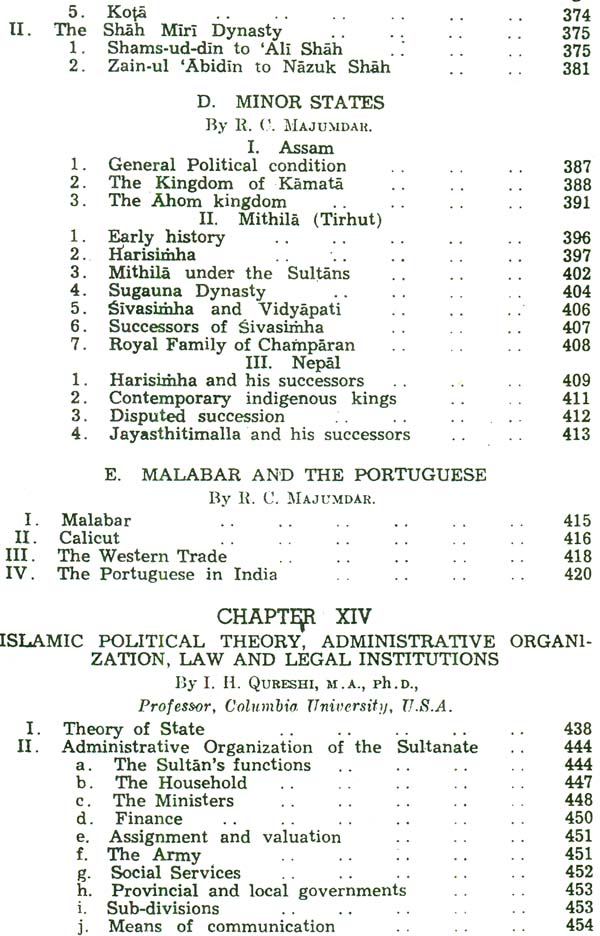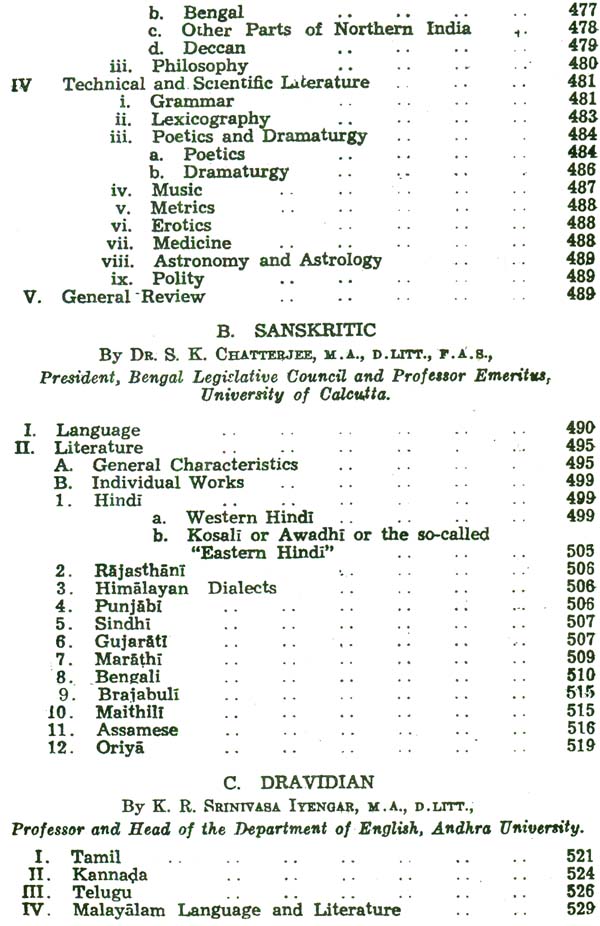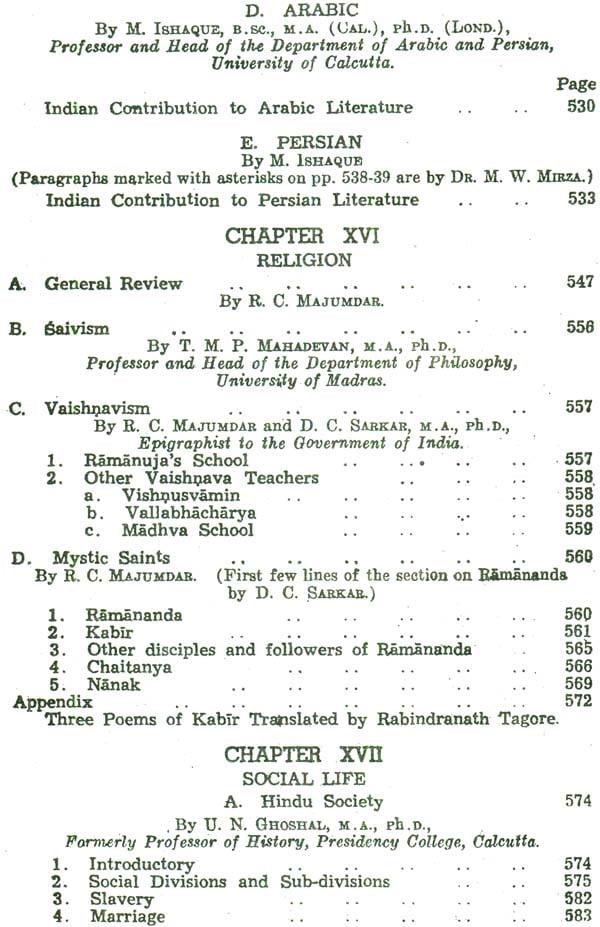
The Delhi Sultanate: The History and Culture of the Indian People (Volum VI)
Book Specification
| Item Code: | NAI196 |
| Author: | R.C. Majumdar |
| Publisher: | Bharatiya Vidya Bhavan |
| Language: | English |
| Edition: | 2006 |
| ISBN: | 9788172765583 |
| Pages: | 920 (66 B/W Illustrations) |
| Cover: | Hardcover |
| Other Details | 9.5 inch x 6.5 inch |
| Weight | 1.40 kg |
Book Description
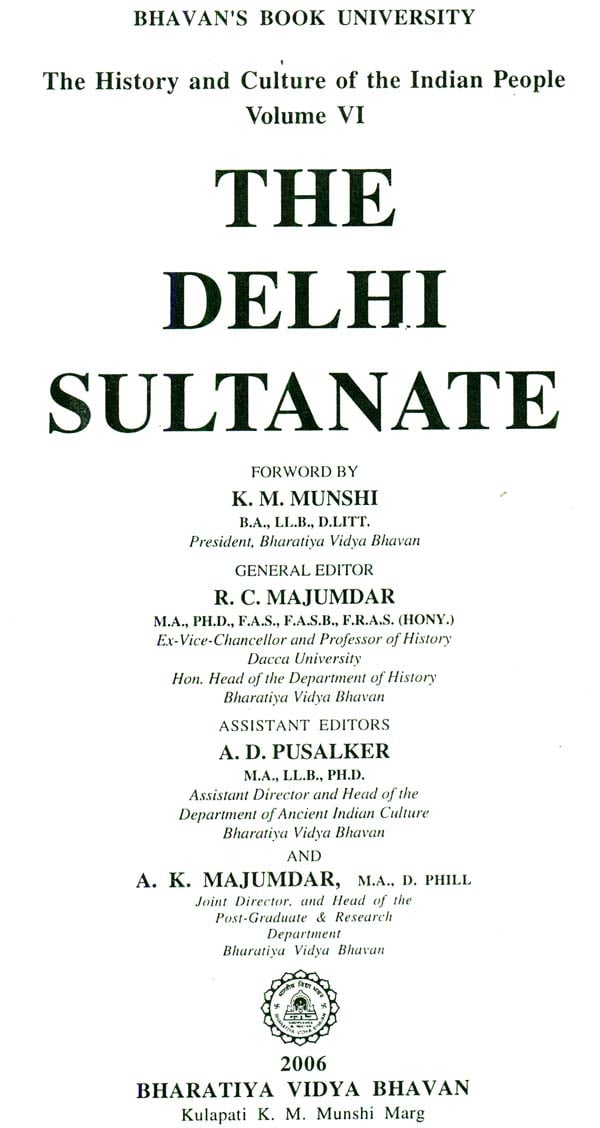
Foreword
On account of heavy pressure of work, I have had to deny myself the usual privilege of writing a detailed foreword to this volume, presenting a view of this age in flowing time.
In preparing this volume, Dr. R. C. Majumdar, General Editor, has had to bear more than· his usual burden and I am deeply grateful to him for his indefatigable and conscientious labours, which were so ably supplemented by Dr. Ashok Majumdar, the Assistant Editor in charge of this volume. My thanks are also due to the scholars who have contributed the different sections of this volume, as also to the Director General of Archaeology who has supplied photo- graphs for the illustrations of this volume.
I again express my gratitude to Shri G. D. Birla, Chairman, and members of the Board of Shri Krishnarpan Charity Trust, for their initial grant, without which the scheme could not Kave been undertaken, as also to the Government of India for their giving us a loan of Rs. 150,000/- for further financing this project. The staff of the Bhavan and its Press have looked after the preparation and printing of this volume with their usual care and deserve congratulations for their zeal.
Preface
This volume deals with the. period during which the foreign Muslim conquerors, mostly of Turkish origin, established 'an effective suzerainty over the greater part of India. The popular notion that after the conquest of Muhammad Ghurfi India formed a Muslim. Empire, under various dynasties, is hardly borne out by facts. It has been shown in the preceding' volume that the major, part of India remained free from Muslim domination till almost the very end of the thirteenth century A.D. It was 'Ala-ud-din Khalji who for the first time established Muslim suzerainty over, nearly the whole of Indi8. But his actual sovereignty did not extend beyond the Vindhyas, save in the Western Decean during the last three years of his reign. The Khalji empire rose and, fell during the 'brief period of twenty years (A.D. 1300-1320). The Tughlaqs, who succeeded the Khaljis, made an attempt not only to revive the empire, but also to exercise an effective sovereignty' over it. But the task proved been their power. The empire of Muhammad bin Tughluq, which included. the southernmost part of India as a province under his governor, broke up within a decade of his accession (A.D. 1325), and before another decade was over, the Turkish .empire passed away for ever India once more presented the spectacle of being divided into a congeries of States both big and small, which always followed the dissolution of an empire in the past. The state of things continued for nearly two centuries and a half till the Mughuls established a stable and durable empire in the second half of the sixteenth century A.D.
Thus, Barring the two very short lived empires under the Khaljis and Muhammad bin Tughluq which lasted, respectively; for less than twenty and ten years, there was no Turkish Muslim empire of 'India. The Delhi Sultanate, as the symbol of this empire; continued in-name·throughout the period' under' review but, gradually shorn of power and prestige, it was reduced to a phantom by the Invasion of Timur at the end of the fourteenth century A.D. Among the States that arose out of the ruins of these two ephemeral empires; six may' be regarded as really very powerful. Three of "these namely the Bahmani kingdom in the Decean, Gujarat in the west, and Bengali in the east were ruled by Muslims, while their rivals and neighbours, namely Vijayanagara in South India, Mewat in Rajputana; and Orissa, along the eastern coast, were ruled by Hindus. The remnant of the Delhi Sultanate and two other Muslim States, Jaunpur and Milwa, also occasionally played an important role. The con- start rivalries and struggles between these States which were generally, but not invariably, grouped on religious lines, form the main feature of the political history of the period covered by this volume. A very prolonged and sustained warfare between Mewar and Gujarat cum Malwa in the west, Bahmani and Vijayanagara in the south, and between Orissa and the last two as well as Bengal in the east, indicates the main trend of politics during the period. These struggles weakened all these powers, but led to no decisive result. The intrigues and dissensions within the Delhi Sultanate, which had a brief revival of power under the Lodis, and its quarrels with the petty States in the north-west paved the way for - the Mughul conquest under Babur.
The political disintegration and lack of a central authority were mainly responsible for two great calamities that befell India in the shape of foreign invasions, both big with future consequences. The first was the invasion of Timur, the Turkish autocrat; who followed in the footsteps of the Mongol Chingiz Khan and carried fire and sword over a large part of the continent of Asia. He had two objects r in view in invading India,-first, to put Islam on a firm footing by 'destroying the infidels (Kafir) and thereby becoming a Ghazi or a martyr', and secondly, 'to plunder the fabulous wealth and valuables of the infidels'. He was no doubt encouraged by the tottering condition of the Delhi Sultanate, and advanced with his hordes towards India. Urged forward by the hope of gaining reward both in this world as well as in the next--a combination of the two incentives most powerful in a medieval Muslim autocrat-Timur let loose the horrors of a barbaric warfare oh the fair cities and plains of India. Never since the days of Sultan Mahmad, four hundred years before, had 'India witnessed such deliberate massacre of the Hindus in cold blood. Fortunately for historians, Timur has. himself recorded. his misdeeds, as it would otherwise be difficult to believe the inhuman atrocities perpetrated by him. Everything that unbridled lust and unchecked barbarism could conceive was perpetrated by his fanatic myrmidons, and the climax was reached in the cold-blooded massacre of one hundred thousand Hindu prisoners outside the plains of Delhi,-an event unparalleled in the history of the world. As attempts have been recently made to minimise and explain away his enormity, the account of his unmitigated barbarity has - been given in some detail, as far as possible in his own words, in Chapter VII.
A century later India was visited by the Portuguese fleet under Vasco da Gama. It was the first scene in the tragic drama which ended with the complete subjugation of India by a European power. Vasco da Gama's name occupies a high place in European history as the discoverer of the route or the means which enabled Europe to exploit fully the resources of the east. But the historians of India are bound to regard him, like Timur and other foreign conquerors beginning from Alexander, in quite a different light. For nearly two centuries he and his followers brought untold miseries upon the people living in the coastal regions, and 'Portuguese' became a by- word for cruelty in India. The historians have, however, generally failed to point out the strong family resemblance between 'Timur and Vasco da Gama. Both were inspired by the same motives acquisition of wealth and promotion of religion, Islam in the one case and Christianity in the other. Both were equally cruel-al- most fiendish in character. The atrocity of Vasco da Gama, though necessarily limited by the means at his disposal, did not differ in kind; save that it had a refined touch of racial arrogance which made it all the more odious. As this aspect of Vasco da Gama is generally shrouded under his well-deserved reputation for exploring the sea- route to the east as in the case of Alexander who similarly explored the land-route-this point has been fully dealt with in Chapter XIII-E IV. It may be further added that Timur' and Vasco da Gama were instrumental in establishing the supremacy, respectively, of the Mughuls and the British In India. The visitations of Timur and Vasco da Gama were thus no mere passing episodes in. the history of the period, but pregnant with big consequences. They also demonstrated the serious defects in the defence system of India, caused by the manifold development in the technique of warfare, both by land and sea, in countries far beyond the frontiers of India within whose seemingly impregnable barriers her people chose to immure them- selves, But the lessons were lost upon men and rulers of India.
